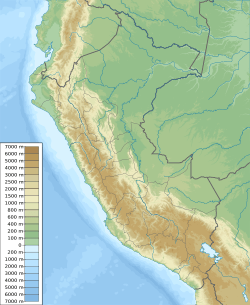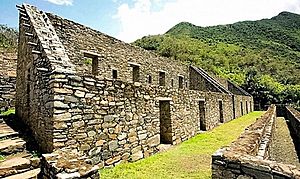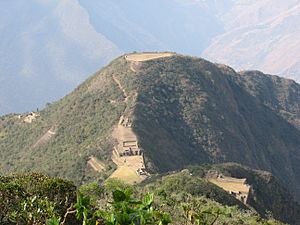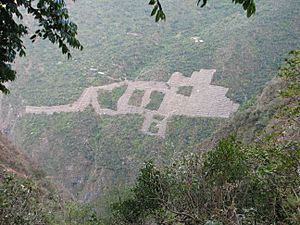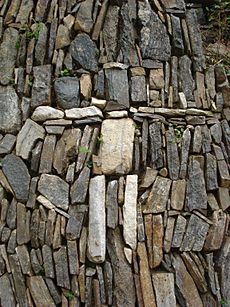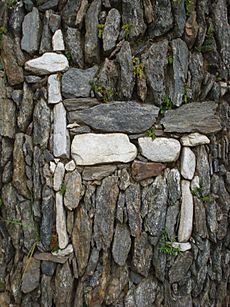Choquequirao facts for kids
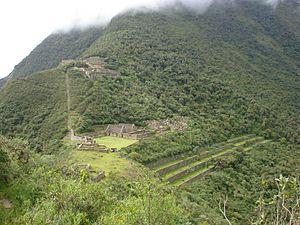
Choquequirao citadel.
|
|
| Location | Santa Teresa, La Convención Province, Cusco Region, Perú |
|---|---|
| Region | Andes |
| Coordinates | 13°23′34″S 72°52′26″W / 13.39278°S 72.87389°W |
| Type | Settlement |
| Area | 18 km2 (6.9 sq mi) |
| History | |
| Founded | 1536 |
| Abandoned | 1572 |
| Cultures | Inca |
Choquequirao is an ancient Inca city in southern Peru. Its name might come from the Quechua words chuqi (metal) and k'iraw (crib or cot). This amazing site looks a lot like Machu Picchu in its buildings and design.
The city has ruins of buildings and terraces. These are found both above and below a flat hilltop called Sunch'u Pata. This hilltop was made flat long ago and surrounded by stones. It created a large platform, about 30 by 50 meters.
Choquequirao sits high up in the Vilcabamba mountains. It is about 3,050 meters (10,000 feet) above sea level. The site covers a huge area of 1,800 hectares (about 4,400 acres). Only about 30-40% of it has been uncovered by archaeologists. The city looks down over the deep Apurimac River canyon.
Getting to Choquequirao is an adventure! It usually takes a two-day hike from outside the city of Cusco. In 2017, Lonely Planet even named Choquequirao as one of the top regions to visit.
Contents
History of Choquequirao
Choquequirao was an important settlement during the 15th and 16th centuries. It was part of the powerful Inca Empire, also known as Tahuantinsuyo. The city grew in two main stages. It is believed that the great Inca ruler Pachacuti first built Choquequirao. Later, his son, Tupac Inca Yupanqui, likely made it bigger and improved it.
This area was considered Pachacuti’s personal land. Other Inca sites like Machu Picchu are also in this region. Many sites nearby, including Choquequirao, share similar building styles. Some parts of Choquequirao's buildings look like they were designed by the Chachapoya people. This suggests that Chachapoya workers might have helped build the city.
Choquequirao was also a place of safety for the Inca ruler Manco Inca Yupanqui. He fled there in 1535 after his fight against the Spanish in Cusco failed. It was one of the last strongholds where the Incas resisted the Spanish.
The Peruvian Tourism Office says Choquequirao was probably a checkpoint to the Vilcabamba area. It was also a center for government, society, and trade. The city's design copied the Inca capital, Cusco. It had special places for worshipping the sun god Inti and other gods. There were also homes for leaders, workshops for artisans, storage buildings, and farming terraces. The city was a key link between the Amazon Jungle and Cusco.
How Choquequirao Was Found
The first non-Inca person to visit Choquequirao was an explorer named Juan Arias Díaz in 1710. The first written mention of the site was in 1768, but it was not widely known then.
In 1909, the famous explorer Hiram Bingham III visited Choquequirao. He was looking for Vilcapampa, the last Inca capital. Bingham found buildings, mummies, and signs that people had searched for treasure. He thought Choquequirao was just a border fort. This made him want to keep searching, which led him to find Machu Picchu later.
Layout and Design
Choquequirao is built on a mountain ridge high above the Apurimac River. The area is full of mountains and Amazon plants and animals. It is about 98 kilometers (61 miles) west of Cusco. The entire complex covers about 6 square kilometers (2.3 square miles).
The main buildings, like temples and homes for important people, are around two main plazas. These plazas follow the Inca city design. There are also many smaller buildings grouped together. These were likely used for workshops and preparing food. Most of the buildings are well-preserved. Restoration work is still happening today.
The Incas changed the land around the city a lot. They flattened the central area and built terraces on the hillsides. These terraces were used for farming and small living areas. The famous Inca terraces are some of the biggest structures at the site.
Many ceremonial buildings at Choquequirao are connected to water. There are special temple sites lower down the mountain. These have carefully built step terraces designed around water. The site also has a large usnu (a ceremonial platform) on a flattened hill. There is also a Giant Staircase and an aqueduct that brought water to sacred water places.
Main Sections
The archaeological site of Choquequirao is divided into 12 sections. Each section has different features, but terraces are common everywhere. Most buildings were likely for ceremonies, priests' homes, or storing food.
- Sector I is the highest part of the site. It has five buildings on terraces, a temple, and two plazas. Some buildings were probably qullqas (warehouses). Three long buildings, called kallankas, were likely homes for priests.
- Sector II has many qullqanpatas, which are storage places. It also has 16 ceremonial platforms with water channels.
- Sector III is the main plaza, called Haucaypata. It has one-story and two-story buildings around it. A Sunturwasi and a kallanka were likely used for ceremonies.
- Sector IV is in the southern part of the complex. Its main building has walls that might have been used for ceremonies. One wall is called the "wall of offerings to the ancestors."
- Sector V is where the usnu is located. This is a hill with a flat, oval top used for ceremonies. From here, you can see the main plaza, snow-capped mountains, and the Apurímac River.
- Sector VI is south of the usnu. It has the Wasi Kancha ("house yard"), also known as the priests' quarters. There are four terraces here with zigzag designs on their walls.
- Sector VII has farming terraces that are much wider than others at the site.
- Sector VIII has 80 farming terraces with water canals. This is where you can find the famous "Llamas del Sol."
- Sector IX contains living quarters for groups like workers or families. The buildings are round and rectangular, connected by stairs and narrow paths.
- Sector X, called paraqtepata, has 18 terraced platforms with irrigation canals.
- Sector XI has 80 terraces for farming, called phaqchayuq ("the one with a waterfall"). These are the largest terraces at the site. It also has small, square buildings used for ceremonies and living.
- Sector XII is a three-hour walk from the main complex. It has 57 platforms with irrigation systems. The highest terraces have ceremonial buildings and a pool fed by a spring.
Ceremonial Center
The ceremonial center of Choquequirao is similar to other Inca sacred sites. The long journey to Choquequirao likely passed by Machu Picchu. The site was chosen for its special location and designed for rituals.
The ceremonial center has a main platform and a lower plaza. Stone channels carried water or chicha (an Inca drink) to shrines and baths. The main platform was very important. Only royalty and priests could enter it through a special doorway. This doorway helped control who could go into the sacred space.
Other structures mark the direction of the sun at certain times of the year. For example, the Giant Stairway faces the sunrise of the December solstice. This structure is 25 meters (82 feet) long and 4.4 meters (14 feet) wide. It seems to have been only for ceremonies. Large boulders on the stairs light up when the December solstice sun rises. This might have "activated" a sacred stone, similar to what happened at Machu Picchu.
In the lower plaza, there are structures that look like water shrines and baths. This is because many water channels lead to this part of the plaza.
Building Materials
All the stones used to build Choquequirao came from nearby quarries. The local rock was metamorphic, so it wasn't as smooth as the stone used at Machu Picchu. Instead, entrances and corners were made from strong quartzite. The walls were built with rough stones, then covered with clay plaster and painted a light orange color.
Art at Choquequirao
Most of the rock art at Choquequirao is found in the farming terraces. Archaeologists have found 25 semi-realistic figures on the terraces of Sector VIII. The walls are made of dark schist rock. The animal images are made of white calcocuarcita, a type of sandstone. These animal pictures are between 1.25 meters (4 feet) and 1.94 meters (6 feet) tall.
In 2004, archaeologist Zenobio Valencia found several figures of camelids (like llamas) made of white stones. These were on a group of terraces. One recent discovery shows a scene carved into the stone terraces. It depicts several llamas carrying cargo, standing next to their handlers. On the top terrace wall, there is a zigzag pattern made of the same white stone. This zigzag style is unique to the Chachapoya people. This suggests that Chachapoya workers might have helped build Choquequirao.
How to Visit
Right now, the only way to reach Choquequirao is by a challenging hike. The most common starting point is the village of San Pedro de Cachora. This is about a 4-hour drive from Cusco. Another way is from Huanipaca village, which offers a shorter 15 km (9 mile) trail. Over 5,000 people hiked to Choquequirao in 2013. From Choquequirao, it is also possible to continue hiking all the way to Machu Picchu. Most treks last 7 to 11 days and involve crossing the Yanama Pass, which is very high at 4,668 meters (15,315 feet).
There are plans to build a cable car to Choquequirao. This project is a top priority for the local government. It will cost about US$82.7 million. The cable car would turn a two-day hike into a quick 15-minute ride! Experts believe it could bring 200,000 tourists in its first year.
Images for kids
See also
 In Spanish: Choquequirao para niños
In Spanish: Choquequirao para niños


